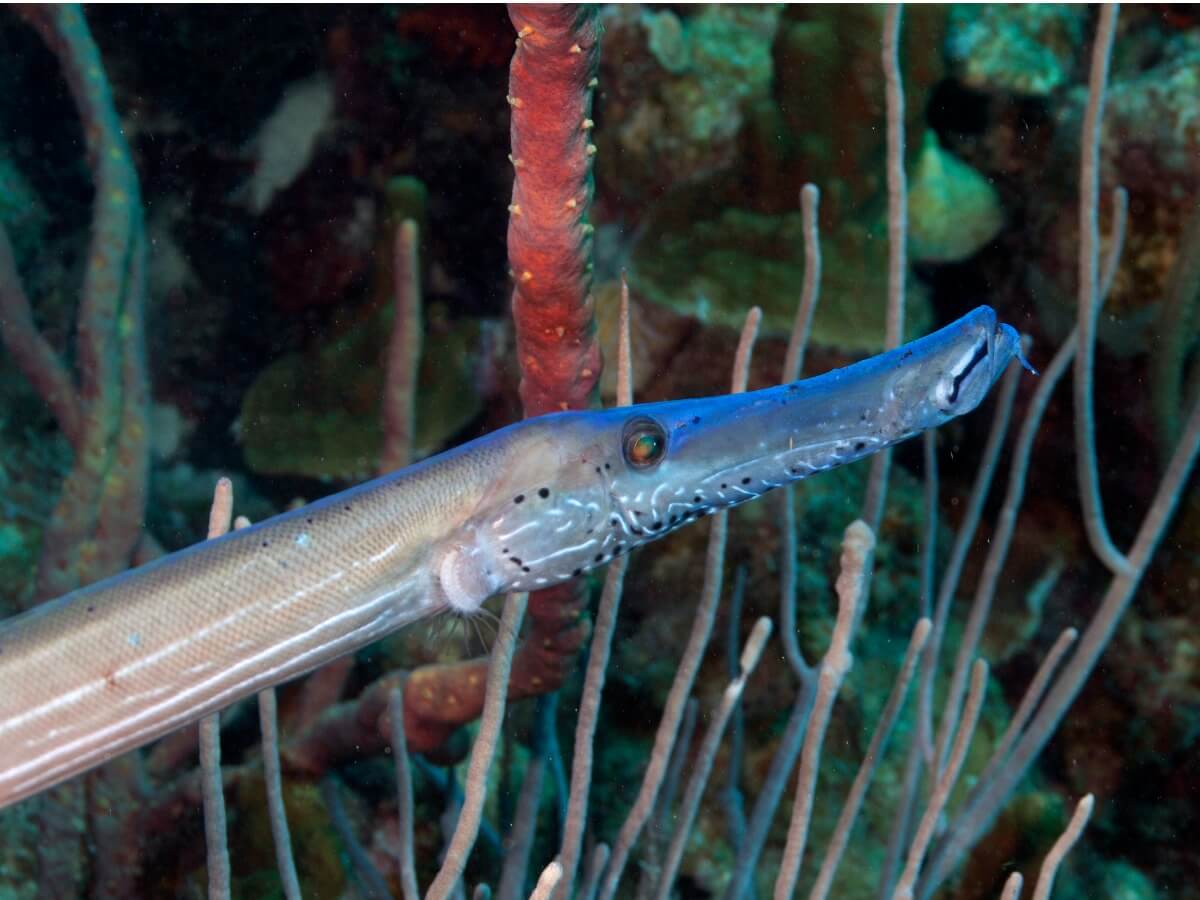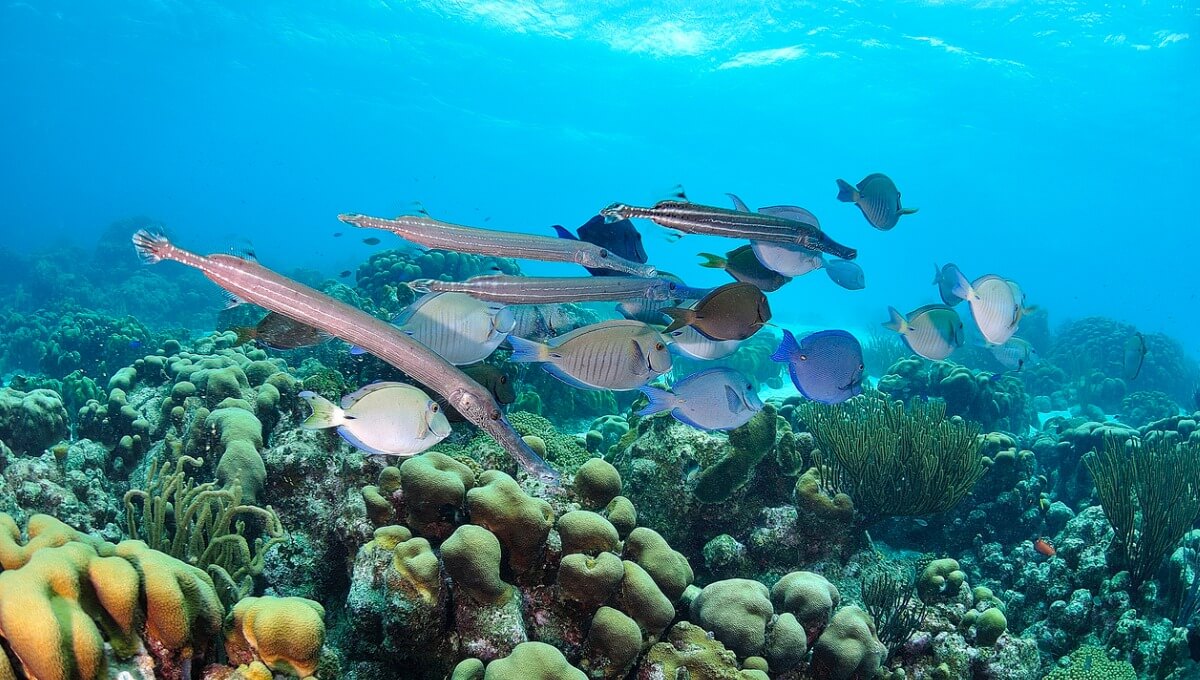Trumpetfish: Habitat and Characteristics


Written and verified by the biologist Samuel Sanchez
The term trumpetfish refers to 3 species of extremely elongated fish that are very similar to each other. They all belong to the Aulostomidae family, and the order of the Signatids (Syngnathiformes). Although they aren’t very similar, trumpetfish share a higher taxon with seahorses.
The very name of the genus Aulostomus gives us information about the characteristics of these fish. The name aulos means flute in Greek and tomus (stoma) refers to its mouth. If you want to know more about this unusual group of actinopterygians, read on.
Trumpetfish habitat
First of all, we should emphasize that the genus Aulostomus comprises 3 different species: Aulostomus chinensis, Aulostomus maculatus and Aulostomus strigosus. We’re going to focus on the most common trumpetfish of all (Aulostomus maculatus). However, we’ll also give some general information about its relatives!
As a genus, trumpetfish are found in various tropical waters throughout the world. Two of the species can be found in the Atlantic (Aulostomus maculatus and Aulostomus strigosus), and the other inhabits the Indo-Pacific (Aulostomus chinensis). They can be found in demersal areas of rocky reefs, near the sea bottoms and in the sediment.
For its part, Aulostomus maculatus inhabits the tropical salty waters of the western Atlantic Ocean, from Florida to Brazil, including the Caribbean islands and the Gulf of Mexico. Its preferred ecosystems are the shallow waters from 2 to 25 meters (7-82 feet) deep and areas rich in corals, This is especially the case in those with a great abundance of vertical structures.

Physical characteristics
These types of fish are characterized by their elongated bodies surrounded by bony rings and very striking tubular mouths. The trumpetfish is no exception to this rule, and that’s why it has received that name.
The Aulostomus maculatus species is quite large. It can reach 91 centimeters (3 feet) in length in its adult stage, somewhat more than the rest of its relatives. Its body is elongated and highly compressed on the sides and it has an extremely long mouth, with a mandibular opening at the end. A type of mustache or barbel can be seen at the tip of the mouthpiece.
The dorsal and anal fins are small, compact, and located far away from the cephalic plane of the fish, giving it an almost serpentine appearance. In addition, its coloration varies according to the individual and the location. However, three specific patterns can be distinguished: red-brown (which is the most common), gray-blue, and yellow-green.
The markings and delineations on the general pattern of colors vary according to the individual.
Trumpetfish behavior
Oddly enough, trumpetfish don’t use a type of movement that’s common to the vast majority of actinopterygian fish. It’s very rare to see a specimen swimming horizontally. This species is “carried away” by the current while maintaining an almost vertical position. As it swims, it turns its head upside down and performs minimal movements.
In addition, as indicated by the PHYSIS Journal of Marine Science portal, the behavior of the specimens varies depending on their general coloration pattern. For example, bluish individuals are found in deeper areas than the yellowish or brownish ones. Body size is also different based on overall tonality.
A king of camouflage
Trumpetfish can use their chromatophores – cells with pigments inside that reflect light – to vary their overall tone and better blend in with their surroundings. Theyre even capable of imitating the movements of a drifting alga while maintaining their vertical position to avoid being detected by potential predators.
As they swim very poorly, these animals are completely dependent on their abilities to camouflage themselves.
Trumpet fish feeding
Fish belonging to the Aulostomidae family are exclusively carnivores. They feed on invertebrates and small fish, but they don’t hunt or chase their prey. Due to their ability to emulate a vertical beam of algae, they wait for their victims to pass in front of them. They then trap them by suction mechanisms.
Thanks to the elastic tissues that make up its mouthparts, the trumpetfish can open its mouth beyond the width of its own body. The rapid opening of this sophisticated mechanism generates a suction effect around the fish, thus dragging the prey into its jaws.
These animals also hide behind some species of herbivorous fish. Thus, their prey aren’t able to see them until it’s too late.
Reproduction of the trumpetfish
The exact reproductive mechanism of trumpetfish isn’t yet totally clear. However, we do know that males use their chromatophores to change color and display courtship signals. Furthermore, this species —and the rest of the signatiforms— have very atypical parental care when compared to the rest of the animal kingdom.
In this species, it’s the male who’s in charge of taking care of the offspring. After external fertilization of the eggs laid by the female, she protects them in a special “bag” until they hatch, taking care of them at all times. This evolutionary strategy has also been adopted by water dragons (Physignathus cocincinus) and seahorses (Hippocampus).
State of conservation
As indicated by the Red List of the International Union for Conservation of Nature (IUCN), the trumpetfish isn’t in danger, and is in the category of “least concern”. However, it has been recorded that their populations are decreasing.
The global decline of kelp beds and corals could make the species’ long-term survival difficult. Furthermore, the spread of lionfish (Pterois volitans) is a threat to this and many other actinopterygians. It’s an invasive and lethal species that feeds on trumpetfish hatchlings, among many other victims.
Although this species isn’tt common in the world of aquarium hobbies, sporadic thefts of specimens for profit have been detected.

As you can see, the trumpetfish is one of the most fascinating actinopterygians in the world. Their way of reproducing, their hunting techniques, and their superb mimicry don’t leave anyone indifferent. Unfortunately, if the destruction of marine ecosystems continues at the current rate, the fish could face a threat in the not too distant future.
All cited sources were thoroughly reviewed by our team to ensure their quality, reliability, currency, and validity. The bibliography of this article was considered reliable and of academic or scientific accuracy.
- Chalfant, D. D. Physical and behavioral differences between the three color morphologies of Aulostomus maculatus. φυσιζ, 15.
- Connect, L. U., & Home, L. U. Aulostomus Maculatus.
- Maul, G. E. (1959). Aulostomus, a recent spontaneous settler in Madeiran waters.
- San Antonio, C. Variation in Threespot Damselfish Aggression Using Models of a Conspecific, Predator, and Herbivore. φύσις, 13.
This text is provided for informational purposes only and does not replace consultation with a professional. If in doubt, consult your specialist.